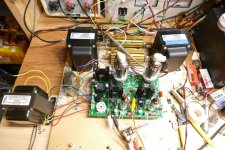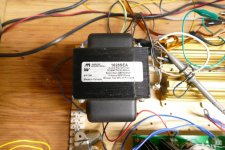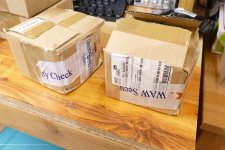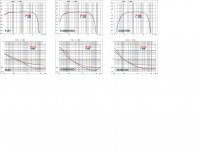The vertical scale is impedance in Kohms, showing the impedance seen by the output tube driving the Hammond's primary winding. The 8 Kohms peak around 13 kHz is where I recall the output frequency response jogged severely.That curve is very different
No worries. I was looking for around £200 the pair inc shipping and insurance.Oh, sorry, I got over excited, and misread 1640 as 1628, so not quite what I'm after. Thanks anyway.
Have you used SE AMP CAD from Glassware Audio? I found it useful though you are restricted in which OSes it runs on.
https://glass-ware.stores.yahoo.net/seampcad1.html
Thanks. That curve is very different from the Hammond 1628SEA, which rolls off smoothly at the top. Tubelab says the SEA is curtailed at the top compared to the Edcor and that the size of its core means a magnetic inertia that can destroy low level information......
Most of the comments and measurements that these comments are based on were made over 15 years ago. I have learned a lot more about tube amps and OPT's in those years. Two pieces of information from the 2006-2007 experiences remain true however.My misgivings about the SEA have been sown by Tubelab. Unfortunately the Edcor has only one output tap and would cost me over £100 more than the Hammond.
1) The original Hammond 1628SE (not the 1628SEA) was pretty useless in most applications. I tried them in several amp designs including a few guitar amps and never found a suitable application, so I sold them real cheap. Most of the amps used a typical audio tube in SE. All were either triode wired pentodes (usually a KT88), or true DHT's.
I also have a pair of Edcor CXSE25-8-5K's in their original "pimp my ride" bright metallic blue paint, and a pair of Hammond 1628SEA's with 2006 dates on them. I bought about 20 "surplus 300B SE OPT's" from Transcendar, some One Electrons, a pair of 5K ohm Electra-Prints, and a few others in my active amp building days from 2005 to about 2009. I dragged a bunch of OPT's disguised in cardboard boxes to a few listening sessions where people got to rate a few different choices from best to worse. There were some trends here, but no clear winners. Measured test data did not always correlate with what people preferred to listen to........
2).....and most of all the SPEAKERS matter, so does the amp to a slightly lesser degree. Play a small triode like a 45 through 106 dB Lowther horns and the $29 Edcor OPT sounds as good, or better than most others, especially the big Hammonds or Edcors. Want to slap some big cones around with Pink Floyd, use a big OPT!
Short, story.....The Electra-Prints went into my personal TSE where they still reside. That amp can run 300B's on about 350 volts into 5K for about 6 WPC, or 45's for about 2 WPC on 320 volts. The Edcor CXSE25-8-5K's went into a modified TSE that ran triode wired 307A's for about 5 WPC. This was the best combination for driving my 96 dB Hawthorne Silver Iris 15 inch Coaxial OB speakers around. That amp was disassembled about 10 years ago since it took up too much space and hence saw little use. My career was on life support and a 1200 mile move was in the retirement plans, so I was in the downsizing mode. The Edcors went back into their boxes and often saw test duty. Most of the Transcendar OPT's went into 300B amps, but a few wound up in SSE's and some were sold. I think I have 2 pair left. The Hammond 1628SEA's have seen test duties in several amps over 15+ years, but never got included in anything I built. They are still in their original boxes next to the Edcors.
As I stated speakers matter. Highly efficient speakers force the amp to operate at a relatively low power level. The average power level is often in the milliwatts range, and some of this power is lost in the OPT itself. Al larger OPT will have more iron and copper, so it will usually be lossier. This may or may not affect the sound. All OPT's have electrical imperfections due to stray capacitance, leakage inductance, winding DC Resistance, and other factors. There are also magnetic imperfections. The choice of magnetic material and wire (silver VS copper) can reduce these imperfections at an often substantial cost increase, so can the method of winding (interleaving and spacing).
The OPT and the tube driving it form a complex electrical circuit which is highly influenced by the load it drives, the speakers. The OPT's imperfections create a parallel resonant notch in the high frequency region. This notch is usually well above the audio frequency range but moves lower as the OPT gets physically bigger. The notch was in the 15 KHz range on the original 1628SE OPT. The parallel resonance creating this notch is effectively in parallel with whatever is feeding the OPT (the output tube and it's circuit). This impedance affects the "Q factor" of that parallel resonant circuit. If the OPT is fed by a low impedance source, its "Q" is reduced making the notch less deep. A 300B has a plate resistance of about 300 ohms. This is why a 300B will bring out the best in many OPT's as its source impedance is quite low. We can apply local feedback to any output tube by several means to improve the performance of almost any OPT. My SSE amp design from 2007 uses cathode feedback to make cheap OPT's sound a little less cheap, but now we can do better.
More recently I have been working on a novel new SE circuit design called UNSET for tube and even solid state amps. About 3 years ago I got the thought to repeat an old test. The trends remain the same as before but the new circuit design provided the OPT with a very low driving impedance making most of the usual imperfections vanish into the background. The test data is here in post #32:
https://www.diyaudio.com/community/threads/unset-is-coming.340856/page-2
I have been listening to this test amp off and on for a couple years now. I even dragged out my old Yamaha NS-10M Studio test speakers from the days of my peak amp building. I ran every OPT I own through this amp, and even bought two pairs of something new, which may be a better option for someone in the UK. I have two pair of SE OPT's from Toroidy in Poland. Their largest SE OPT would do quite well in a KT88 or 807 based amp and they are less $$$ than Hammond or Edcor, but that's not what this thread is about. My Toroidy's will be used in a few test amp builds for something even newer than UNSET, so I must choose from what I already have when I build a box for this test amp. The test data does not show enough conflicting information to make a decision, and my nearly 70 year old ears aren't what they used to be, so I just kept swapping transformers until I got tired of changing them. These are what I'm going with. It's the multiple output taps that sealed the deal since I could not make a choice based on measurements or sound quality.
Attachments
Thank you for sharing your experience and knowledge Tubelab. I looked at the Toroidy website. They are indeed cheaper, although I'm not sure about shipping to UK. However they list the 5k primary model for EL84s and the 3K version for KT88s which is curious. Which model did you buy?
5K ohms is a middle of the road load for an EL84. You could get a bit more power with the textbook 3500 ohms in triode mode, but some pentode applications prefer as much as 7 to 8K ohms. 3K ohms is the accepted "audiophile" load for a 6550A or KT88 wired as a triode.However they list the 5k primary model for EL84s and the 3K version for KT88s which is curious. Which model did you buy?
Look on TME's website. They are like a Farnell in Poland and they stock Toroidy OPT's. Fedex shipping from Poland to the USA was $19 for 6.7kg. I just noticed that their prices have increased since I ordered my transformers, but so has everything.
I got a pair of their TTG-KT88PSE transformers and a pair of TTG-6C33CSE's. The KT88PSE's are 1500 ohms and intended for a pair of KT88's in triode mode. I got them for some TV sweep tubes in UNSET mode, but they also work well as 3000 ohm OPT's by putting an 8 ohm load on the 4 ohm tap. Another forum member has tested this configuration against Toroidy's standard 3000 ohm KT88 transformer and prefers the miswired KT88PSE. The 6C33 transformers are 600 ohm and intended for a cathode follower output stage.
Note that Toroidy calls the KT88PSE a 60 VA transformer. It will not pass 60 watts at 20 Hz, not even close. Neither will the big Edcor or Hammond. The KT88PSE is "intended for a pair of KT88's or 300B's" in SE operation. A pair of KT88's or 300B's in SE can deliver 20 watts at best, and the Toroidy KT88PSE will do 20 watts down to below 30 Hz which is far better than my speakers will do, so they are appropriate for a pair of KT88's and excellent for a single tube when miswired for 3000 ohms.
The test amp on my bench is currently using the 1628SEA's as 2500 ohm OPT's by using the 16 ohm tap for my 8 ohm speakers. It does this well, but losses increase a bit. Many OPT's do not work well when miswired for other than the specified impedance, so testing is required. The Edcor only has a single 8 ohm secondary making it a 5K ohm only OPT. I would need well over 550 volts of B+ to get 20 watts from a 5K OPT. I get 20 watts on 400 volts using a power transformer that I already have with a 2500 ohm load. I could use the miswired Toroidys for 20+ watts on 450 volts, but I need them for science experiments and I do not have a suitable power transformer handy.
Given a choice as to the Hammond, Edcor, and Toroidy today for a typical triode wired SE KT88 amp like the SSE, I would go with the Toroidy KT88PSE unless I needed a 4 ohm output. Their usual KT88 SE OPT might be a good choice, but I have not tried them. A triode wired KT88 presents a higher output impedance than a 300B, so OPT imperfections in the high frequency range will be more pronounced.
Great information. Thanks. Unfortunately TME have suspended shipping to individuals in UK since Brexit. I can contact Toroidy directly to see if they will ship to UK. Thanks again. M
George (Tubelab) did extensive testing of these and other transformers. There are some threads on this site with him entering into the discussion.
The following articles on his website both test and discuss these transformers.
http://tubelab.com/articles/component-testing/output-transformers/
http://tubelab.com/articles/component-testing/budget-output-transformers/
Steve
The following articles on his website both test and discuss these transformers.
http://tubelab.com/articles/component-testing/output-transformers/
http://tubelab.com/articles/component-testing/budget-output-transformers/
Steve
No problem, the old data is still valid, but I have found ways to squeeze more performance from a given OPT in the past 15 years. This just happens to work wonders on Hammond OPT's.George
I did not see your post before I posted the links to your website.
Apologies.
Steve
I had memories of old threads discussing SE OPT's including Edcor, Hammond, Toroidy and the now extinct Transcendars. It took some digging, but I found them. I had more detailed explanations about OPT and stuff scattered through them, so they might be worth readins before spending money.
This one is not just about Transcendar, it's about the possible alternatives, and does contain some biased opinions:
https://www.diyaudio.com/community/threads/transcendar.377360/page-2
This one is about low buck SE OPT's and where I learned about Toroidy.
https://www.diyaudio.com/community/...re-the-current-suppliers-for-not-many.347940/
Years a go builder Decware used Hammond OPTs, afew years later/now they are using Edcor apparently, certainly there was a SQ reason imo.Useful info FullRangeMan. Thanks. Hammond seem to have addressed the top end nasty issue in the SEA. They have also reduced the copper losses from 439R t0 171R. The leakage inductances look a bit high though.
My misgivings about the SEA have been sown by Tubelab. Unfortunately the Edcor has only one output tap and would cost me over £100 more than the Hammond.
I've seen a lot of praise for the Toroidy OPTs. When ordering from the USA, how's the shipping been? Any problems with customs?
I ordered mine from TME. I have done two separate orders for a pair of transformers each. I don't remember exactly, but I think the first pair took about two weeks to arrive by Fedex. Fedex in this rural area is known to be less than reliable, and a 10 day delivery time for a small order from Digikey is not uncommon. The last order from TME surprised me. TME shipped it in a day and Fedex put the transformers on my porch 3 days later. This includes time taken to open the outer package and each transformer box for a "security check" in Warsaw and a "temporary delay" in Paris. ** *** was in Warsaw at the time these OPT's were, but the security check might have been a coincidence, but a heavy box that revealed two metallic lumps on the X-ray scanner.......
Neither order from TME or any of my direct from China stuff have ever incurred any interest at all from customs, but they are infrequent and always under $300 USD.
Neither order from TME or any of my direct from China stuff have ever incurred any interest at all from customs, but they are infrequent and always under $300 USD.
Attachments
Last edited by a moderator:
I want to build a single ended KT88 amp and/or an 807. In the UK I can source the Hammond 1628SEA and the Edcore CXSE25-8-5K. I've seen some discussion of these two. There have been some disparaging remarks about the Hammond's top end. If anyone has experience of these I'd appreciate hearing about it. I would have liked to chose the Hammond as they have several output windings/taps, that give matching flexibility and are considerably cheaper than the Edcors. However I don't want to sacrifice sound quality if there is a big difference. Cheers. Matt
Hi
there is a simply and fine method to test at the best the OT trafos.
this an old thread
https://www.diyaudio.com/community/threads/opt-characterization.313957/
With a minimum of test set up as a ausio card at 24 bit/192 kHz and an attenuator with Arta or Visual analyzer is possible to get a good ideas about quality from low level signal until the max possible.
Here a copy from an article dedicated to the measure on Audioreview magazine in Italy
There are diagram form two types of proto, one with C nucleus and standard wire the other with Litz; also with different Ibias and the last without .
Frequency answer and THD vs Frequencies
Walter
Years ago SAC-Thailand tested various OPTs,
The Hammond 1628SE was not good:
http://www.sacthailand.com/transformer_testoutput.html
http://www.sacthailand.com/Transformer_OutputTestGraph.html
Hi
The test from SAC are not specified in the details so the results can't be take in consideration.
And the method is wrong because it takes the entire ouput stage and not the trafo itself.
So the parasitic of the tube interact with the parasitic of the trafo
Plus other considerations
Walter
Walter, i consider the test at SAC as very good. This is just as we will use a transformer in our home amplifiers.
And how big would be the difference? I did a small test with my own transformer, 3300Ω to 4&8Ω.
First with a KT88 at 77mA:

and secondly with my generator only (50Ω output imp + 667Ω = 716Ω output imp)

Yes, its better but to be honest, who cares about the difference?
And how big would be the difference? I did a small test with my own transformer, 3300Ω to 4&8Ω.
First with a KT88 at 77mA:
and secondly with my generator only (50Ω output imp + 667Ω = 716Ω output imp)
Yes, its better but to be honest, who cares about the difference?
To Tubes
personally I am looking to find a right trafo for my purpose; so the right tests can help me to understand.
And can't be only a frequency answer at low level that can tell me the information.
Of course everyone has a personal point of view.
Walter
personally I am looking to find a right trafo for my purpose; so the right tests can help me to understand.
And can't be only a frequency answer at low level that can tell me the information.
Of course everyone has a personal point of view.
Walter
To Tubes
personally I am looking to find a right trafo for my purpose; so the right tests can help me to understand.
And can't be only a frequency answer at low level that can tell me the information.
Of course everyone has a personal point of view.
Walter
I agree that only a frequency response isn't enough.
If i look at your publish graphs in post 34 i can clearly see that there are resonance problems in both transformers. I bet a lot of ringing.
And if i look at the link for the article is see also that the transformer has high distortion at low frequencies.
Probably nothing to worry about in an average amplifier if there is no overall feedback.
The two trafos are protos to test two different coils, standard and Litz.
About resonance they are at 100 kHz and more and the ringing with complete stage is not present (or in minumm quantity)
But the power test are 1 watt, that means 52 volts rms on primary ( as secondary), 110 volts rms for 5 watt and around 155 Vrms for 10 watt; all voltage on a load of nominal 2500 ohm. The Zs is 6 ohm.
You can understand that is completely different from the standard test we normally see.
About the thd at low frequency the value is not so high, the core is double C laminated 0,1 mm; probably a better iron give me better results but this is not the main problem.
In attach the tes on other three trafo
Walter
About resonance they are at 100 kHz and more and the ringing with complete stage is not present (or in minumm quantity)
But the power test are 1 watt, that means 52 volts rms on primary ( as secondary), 110 volts rms for 5 watt and around 155 Vrms for 10 watt; all voltage on a load of nominal 2500 ohm. The Zs is 6 ohm.
You can understand that is completely different from the standard test we normally see.
About the thd at low frequency the value is not so high, the core is double C laminated 0,1 mm; probably a better iron give me better results but this is not the main problem.
In attach the tes on other three trafo
Walter
Attachments
Walter, If the resonance is at 100kHz-200kHz you would see for sure* a clear ringing on squarewaves (10kHz but probably also on 1kHz) . Only if your test equipment is frequency limited (<200kHz) you would noticed it much less.
* for sure if you test only the transformer and not with a frequency limited amp or frequency generator
btw my test equipment is limited at 20MHz
Here you see the frequency respons from the transformer i have used (test with a serie resistor totall imp 716 OhM). As you can see resonance frequency is at a lot higher and also a lot less then your proto types, it's better damped)

And here the 10kHz squarewave test (but measured with a source imp of 1050 Ohm)

* for sure if you test only the transformer and not with a frequency limited amp or frequency generator
btw my test equipment is limited at 20MHz
Here you see the frequency respons from the transformer i have used (test with a serie resistor totall imp 716 OhM). As you can see resonance frequency is at a lot higher and also a lot less then your proto types, it's better damped)
And here the 10kHz squarewave test (but measured with a source imp of 1050 Ohm)
Last edited:
- Home
- Amplifiers
- Tubes / Valves
- Hammond and Edcor SE X'fmrs compared



